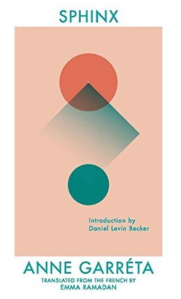August is Women in Translation Month (#WITMonth), so I’m only reviewing books by women in translation.
What does Anna Karenina look like? When you read Moby Dick‘s opening line, “Call me Ishmael”, what face do you picture? How does your mind’s eye interpret Joyce’s description of Ulysses‘ Buck Mulligan as “plump, stately”? One of my favourite books of all time, an essay aptly titled What We See When We Read, by graphic artist Peter Mendelsund, asks all these questions, dismantling the notion that when we read it’s like we’re watching a film in our head. What happens in our head when we translate words on a page into images is a much stranger process–one that, if turned into an actual film, would probably involve blurry entities floating around in blurry spaces, with certain body parts and places occasionally coming into focus when the author calls our attention to them, only to reveal taht they are in fact our neighbour’s face, our childhood home, that guy on that poster we walk past every morning. Since reading What We See When We Read, I often enjoying observing how my brain tries to picture things while I read them, and some books turn out to be particularly interesting challenges.
 One of these is Anne Garréta’s Sphinx. In the Oulipian tradition of drawing inspiration from a fiendish formal constraint, Garréta’s novel is a love story where the lovers’ gender is never revealed. (I will refer to them throughout as “the narrator” and “A***”.) This required considerable linguistic challenges in the original French, where even verb tenses can reveal someone’s gender. Without detracting from Emma Ramadan’s excellent translation, the feat is not as difficult in English–especially for one of the lovers, who narrates the whole story from the first person perspective. All the same, I suspect that, like mine, much of many readers’ brain energy will be invested in figuring out the characters’ gender, grasping at the tiniest detail for clues. The author’s a woman–so maybe the narrator is female? A*** is a dancer, so maybe they’re female too? Or is the fact that they’re loud and flamboyant and sculpted like Michelangelo meant to signal that they’re a gay man? Of course, in the end, there is no correct solution: the whole point Garréta is making is that gender is an irrelevant category when it comes to romance and sex. But the stupid brain wants what the stupid brain wants.
One of these is Anne Garréta’s Sphinx. In the Oulipian tradition of drawing inspiration from a fiendish formal constraint, Garréta’s novel is a love story where the lovers’ gender is never revealed. (I will refer to them throughout as “the narrator” and “A***”.) This required considerable linguistic challenges in the original French, where even verb tenses can reveal someone’s gender. Without detracting from Emma Ramadan’s excellent translation, the feat is not as difficult in English–especially for one of the lovers, who narrates the whole story from the first person perspective. All the same, I suspect that, like mine, much of many readers’ brain energy will be invested in figuring out the characters’ gender, grasping at the tiniest detail for clues. The author’s a woman–so maybe the narrator is female? A*** is a dancer, so maybe they’re female too? Or is the fact that they’re loud and flamboyant and sculpted like Michelangelo meant to signal that they’re a gay man? Of course, in the end, there is no correct solution: the whole point Garréta is making is that gender is an irrelevant category when it comes to romance and sex. But the stupid brain wants what the stupid brain wants.
 This is not the first book where I’ve had such an experience when it comes to gender. Emma Ramadan, in her afterword, writes that a genderless book has yet to be written in English, but that’s not entirely true. In Ann Leckie’s 2013 space opera Ancillary Justice, the narrator comes from a culture where gender is irrelevant, and, in order to convey this, Leckie only ever uses feminine pronouns. This is, again, extremely disorienting at first, though, weirdly, I ended up imagining all characters as male, except for the narrator. I guess my brain enjoyed the “wrongness” of reading female and picturing male. But the main difference between Ancillary Justice and Sphinx in their approach to gender is that, in Ancillary Justice, the gender thing becomes something you get used to, and it doesn’t influence the narrative barring the occasional cultural misunderstanding, while in Sphinx the characters’ genderlessness ends up informing the whole novel. For example–as Ramadan explains in her excellent afterword, the most common French past tense immediately reveals the subject’s gender, so Garréta was forced to use two other past tenses, to whom gender is irrelevant. One of these tenses is very literary and uncommonly used, and to make its usage make sense, Garréta made the narrator snobbish and pretentious, given to baroque sentences and word choices. The other tense expresses habitual action, so the narrator is constantly picking up habits, and doing the same things over and over again, always eventually getting bored with them but doing them anyway.
This is not the first book where I’ve had such an experience when it comes to gender. Emma Ramadan, in her afterword, writes that a genderless book has yet to be written in English, but that’s not entirely true. In Ann Leckie’s 2013 space opera Ancillary Justice, the narrator comes from a culture where gender is irrelevant, and, in order to convey this, Leckie only ever uses feminine pronouns. This is, again, extremely disorienting at first, though, weirdly, I ended up imagining all characters as male, except for the narrator. I guess my brain enjoyed the “wrongness” of reading female and picturing male. But the main difference between Ancillary Justice and Sphinx in their approach to gender is that, in Ancillary Justice, the gender thing becomes something you get used to, and it doesn’t influence the narrative barring the occasional cultural misunderstanding, while in Sphinx the characters’ genderlessness ends up informing the whole novel. For example–as Ramadan explains in her excellent afterword, the most common French past tense immediately reveals the subject’s gender, so Garréta was forced to use two other past tenses, to whom gender is irrelevant. One of these tenses is very literary and uncommonly used, and to make its usage make sense, Garréta made the narrator snobbish and pretentious, given to baroque sentences and word choices. The other tense expresses habitual action, so the narrator is constantly picking up habits, and doing the same things over and over again, always eventually getting bored with them but doing them anyway.
One thing I do wonder about, though, is the novel’s approach to race. As a white man who’s never been in an interracial relationship, there’s not a whole lot I can say about the subject, but certain elements of how the relationship between the narrator and A*** is described, as well as the narrator’s visit to Harlem, seemed pretty dodgy. It’s not entirely clear to me whether this simply reflects the fact that the author was, at the time, a white European woman writing in the 1980s, with all the blindspots and prejudice that that entails, or whether this is a deliberate choice on her part, an intended aspect of the narrator’s psychology. It is true that the (white) narrator is given to slumming it at home in Paris, so it does seem to fit that they would force an unwilling A*** (who is black, and from New York) to take them for a tour of Harlem (which the narrator experiences as a hellish place that was nevertheless profoundly transformative). Then again, Gaëlle Cogan’s excellent, in-depth review over at the Kenyon Review–the only one I could find where race is mentioned–does suggest that the novel’s jarring approach to race is at least partly reflective of Garréta’s own biases, as some of the more unfortunate word choices in the original French have been “softened” in Ramadan’s translation. (Cogan’s review is very, very good, and I recommend you read it.)
In the end, however, I do subscribe to the notion that you can enjoy media while being aware of its problematic aspects, and Sphinx is definitely a book I enjoyed, and that I would recommend. Read it for its rich, decadent prose, its amusingly pretentious narration, and, most importantly, its exciting, forward-looking approach to gender. However–don’t expect a joyous celebration of queerness or genderfluidity. Barring a couple of chapters in the middle, Sphinx is pretty gloomy stuff.
Advertisements Share this:




